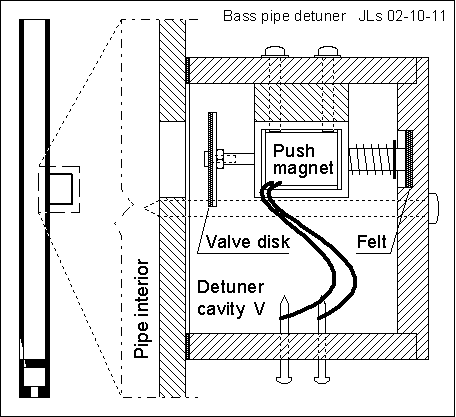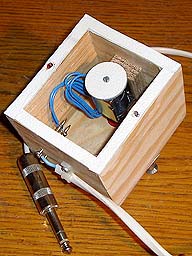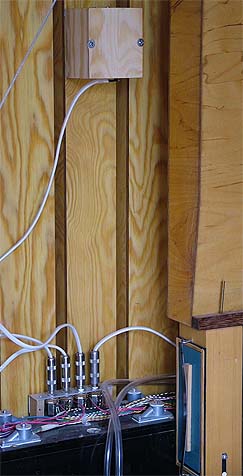
Already Audsley (The Art of Organ Building, Vol II, p 497, fig CCCIX) outlines a remedy for this problem in a limited size house organ. In an open pipe you make a big tone hole near the top and cover this with a pneumatically operated valve cap. When the hole is uncovered the effective resonator length decreases such that pitch rises a semitone. This is the same principle as used in orchestral woodwinds, but is awkwardly clumsy due to the size of a bass pipe.
The workaround used here is to do something at a pressure maximum in the pipe, instead of modifying the resonator at a pressure minimum (open end). Just below the stopper in a closed pipe, at the middle of an open pipe. At these places acoustic flows are minimum, so any holes needed may be small. Here you connect an acoustic compliance, a closed cavity. At a flow minimum (pressure maximum) the resonator air is immobile and acts mainly as a compliance, so the important property is the volume of it. So adding a closed volume here will detune the pipe lower. Suppose the original pipe has a length L. One semitone lower would require 1.0595*L, about 6% longer. So the required extra volume is estimated to be 6% of the resonator length, multiplied by the pipe cross sectional area Ap.
V=0.06*L*Ap
There is an important restriction: The additional cavity and its connecting hole into the pipe wall make up a Helmholtz resonator. It is imperative that the resonance of this is higher than the pipe frequency, otherwise the pipe interior will not feel it as a compliance. Near its Helmholtz resonance the resonator attains a low resistive input impedance, it becomes a loss element rather than a compliance element. For instance, if the resonator goes at the same frequency as the pipe, then the pipe will feel it equivalent to a plain hole and overblow. Prescribing the Helmholtz resonance to exceed pipe frequency by a safety factor of two, and some formula juggling, I arrive at a minimum hole area Ah, as fraction of the pipe cross sectional area Ap to be
Ah/Ap = 2.4*Lh/Lp
where Lh is the length of the connecting hole (= wall
thickness
plus end correction) and Lp is the length of the (open)
pipe.
It is interesting that the required hole area does not vary too much
along
the tonal range. For a pipe scale halving number M=24, then Ap
and Lp go in proportion, suggesting a constant hole
diameter.

The G, c, d, and f pipes are the ones modified. On each of them the
tuning slots were checked/deepened such that I could tune the pipes to
be one semitone high (#G, #c, #d, #f). The pipes were re-tuned to these
sharp notes.

On these pipes a 20 mm hole was drilled at the middle along the resonator. Boxes were made to cover the holes with a cavity of volume as computed above. When the hole is (tightly!) covered by that box, then the original (un-sharpened) pipe frequency is approximately restored. I did not care to make any adjustable fine tuning device, would only have made it more difficult to have the device airtight.
A push magnet (Schroff 12V, 68 Ohms) inside the detuner box can close the hole into the pipe, to make it speak at the sharp note. The reason to use a push magnet is that this will give its maximum force when the valve is closed. This is a definite advantage compared to using a conventional chest magnet which is designed to be held close only by its return spring and the (here non-existent) blowing pressure. The detuner valve has to cope with the oscillating pressure at the middle of the resonator. The amplitude of this is substantial, not much less than the blowing pressure.
Above is a drawing and photo of a detuner box. The push magnet has
its
iron armature surrounded by a weak return spring, extending rightward
in
the drawing, resiliently stopped against a felt pad. A brass pushbar
extends
left of the coil when it is energized. The valve disk is held by a
small
screw and locking nut, threaded into the end of the pushbar.

Here a photo of the rear side of the bass pipes section. You can
see a detuner box, electrically connected with a 1/4 inch telephone
plug,
making it easy to take a pipe out of the organ. For visibility, some
otherwise obscuring
bass reed pipes have been removed.
From the MIDI
interface 8 wires come to activate the playing valves
for the eight pipes. Another four wires go to the detuner magnets. To
play
one of the sharp notes I have to give signals both to the playing valve
and to the detuner. This is performed with diodes, such that activating
one of the detuner magnets, then I also automatically open the playing
valve of that pipe. The diode is to block action the wrong way round -
playing a 'regular' note on its playing valve, the detuner is blocked.
The phone plugs and jacks are 3 pole stereo style. I put the diodes
inside
the plug handles. This also insures that activating one of those
sharps,
the playing valve is opened only if the corresponding detuner plug is
actually
installed.
Some care must be taken in arranging music. The reed rank on the same chest has no correspondent to the detuners, so with this only the eight original notes are available.